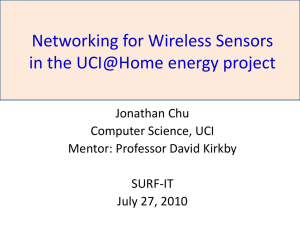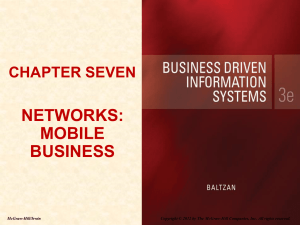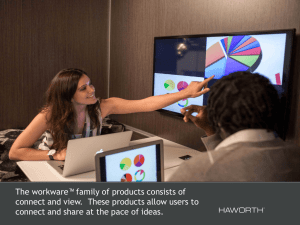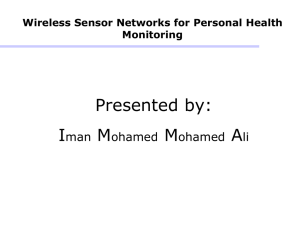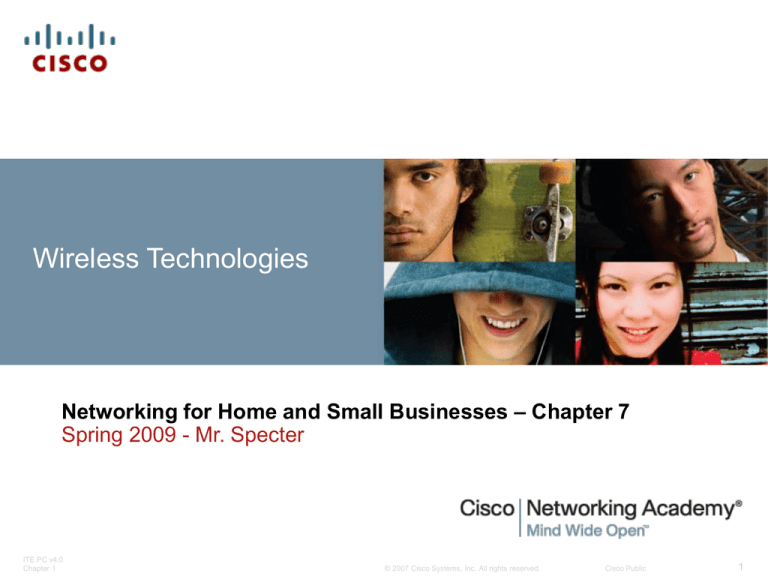
Wireless Technologies
Networking for Home and Small Businesses – Chapter 7
Spring 2009 - Mr. Specter
ITE PC v4.0
Chapter 1
© 2007 Cisco Systems, Inc. All rights reserved.
Cisco Public
1
Objectives:
Describe wireless technologies.
Describe the various components and structure
of a WLAN
Describe wireless LAN security issues and
mitigation strategies
Configure an integrated wireless access point
and a wireless client .
CCNA 1 - Chapter 7 - Mr. Specter
2
Electromagnetic Frequencies
All use waves in the Electromagnetic spectrum to transfer
information from device to device.
Electromagnetic spectrum includes bands used for radio, TV,
and visible light.
CCNA 1 - Chapter 7 - Mr. Specter
3
Wireless Technologies
Infrared Band (IR)
– Low energy and unable to penetrate walls (line of sight)
• Could this be a benefit?
– Used for PDAs, PCs, wireless mice, keyboards and remote controls
– IrDA (Infrared Direct Access) port used for 1 to 1 connections
Radio Frequency (RF)
– Goes through walls and other obstructions, better range
– Different frequencies assigned to different types of unlicensed devices
(900MHz, 2.4GHz, 5GHz)
• Cordless Phones
– Problem with 900MHz?
– Used for military and civilian emergency bands outside US
• Wireless LANs
• Computer Peripherals
• Bluetooth uses 2.4 GHz band for low-speed, short-range, many
devices at once
CCNA 1 - Chapter 7 - Mr. Specter
4
Wireless Technologies
Pros
Cons
– Anytime, anywhere connectivity with
hotspots
– Easy and cheap installation
– Device prices dropping
– Data rate capabilities increasing
– Easy expansion
CCNA 1 - Chapter 7 - Mr. Specter
– Unlicensed RF which is crowded
with other devices
• Bluetooth
• Microwaves
• Cordless phones
– Security is difficult because there is
no way to limit who can intercept the
wireless signal
• Encryption helps, but can be
defeated
– Fluctuations in temperature and
humidity can really affect
transmission range.
5
Wireless Network Categories
Wireless networks are difficult to categorize because boundaries cannot be
precisely defined.
CCNA 1 - Chapter 7 - Mr. Specter
6
Wireless Network Technologies
Technologies used for the different network types:
CCNA 1 - Chapter 7 - Mr. Specter
7
WLAN Standards
Many different standards have been adopted for wireless
networks
– IEEE 802.11n is latest standard adopted (except for 802.11y)
– Wi-Fi Alliance tests devices from various manufacturers to make sure they
operate together.
Protocol Release
Date
RF
Freq.
Through
put
Data
Rate
(Max)
Max
Range
Notes & Comments
802.11
1997
2.4 GHz 0.9 Mbps 2 Mbps
Undefined Legacy
802.11a
1999
5 GHz
50m
Not compatible with b, g, n
Expensive
802.11b
1999
2.4 GHz 4.3 Mbps 11 Mbps
100m
First 2.4 GHz Technology
802.11g
2003
2.4 GHz 19 Mbps 54 Mbps
100m
Backward compatible with b
Shares range with b
802.11n
2009*
2.4 & 5
GHz
802.11y
2008*
3.7 GHz 23 Mbps 54 Mbps
23 Mbps 54 Mbps
74 Mbps 248 Mbps 250m
CCNA 1 - Chapter 7 - Mr. Specter
5000m
Newest Standard
Newest Standard
8
Structure of a WLAN
Wireless Components
– Wireless Clients or
STAs (Wireless
STAtion)
– APs (Access Points)
– Wireless Bridges
Types of Antennas
– Omni send all
directions
• Used in APs
– Directional send in one
direction
• Used for longer
links to bridge
distances
CCNA 1 - Chapter 7 - Mr. Specter
9
WLAN Types
The Service Set Identifier
(SSID) used by components
to connect to a particular
WLAN.
– 32-byte Alphanumeric String
– Used in Frame Headers
CCNA 1 - Chapter 7 - Mr. Specter
Two forms of WLAN
Installations
– Ad-hoc - IBSS
• Equal Peer-to-peer
• No AP
– Infrastructure - BSS
• STAs communicate through APs
• BSS is an area with a single AP
10
Wireless Channels
Channels are created by giving each a part of the RF spectrum
– Each one can carry on a separate conversation (Think of a TV)
– Can be set manually or automatically
Channels will often overlap frequencies, but conversations cannot overlap
Newer technologies combine channels into a wider one for better bandwidth
CCNA 1 - Chapter 7 - Mr. Specter
11
CSMA/CA
A WLAN technology designed to
make collisions impossible
Carrier Sense Multiple Access with
Collision Avoidance (CSMA/CA).
– Reserves a channel for use by a
conversation
– No other devices can transmit on that
channel
CSMA/CA Reservation Process
– For a Device to use a channel, it asks the
AP by using a Request To Send (RTS)
message.
– If channel is not in use, AP will send Clear
To Send (CTS) message to all devices in
the BSS so they know the channel is
being used.
– Data is sent from STA
– After conversation is done, an
Acknowledgement (ACK) is transmitted.
CCNA 1 - Chapter 7 - Mr. Specter
12
Wireless Access Point Configuration
Integrated wireless access
point
– Network Mode
• 802.11b, g, or a different
technology
– SSID
• Name of your wireless
network
– Standard Channel
• Default is AUTO, but this
decides which channel will be
used
– SSID Broadcast
• Sends out the SSID to the
world
• Default is ENABLE
CCNA 1 - Chapter 7 - Mr. Specter
13
Wireless Client Configuration
Client software allows hardware to
connect to the WLAN.
For connection to occur, the SSID,
security settings, and channel must
match the AP.
Wireless Utility Software usually comes
with the NIC
Some features
– Link Information: strength and quality
of signal
– Profiles: specify configuration options
– Site Survey: checks for all WLANs in
the area
– To use the vendor software, Windows
XP wireless software must be disabled.
For most purposes, XPs built-in
wireless drivers can be used.
CCNA 1 - Chapter 7 - Mr. Specter
14
Wireless LAN Security Issues & Mitigation Strategies
One large benefit to Wireless networks is also biggest
vulnerability: transmission of information through the air.
Attacks don’t need physical access to equipment, just be in
range.
– War Driving or Walking to discover insecure networks
If they gain access, an attacker can:
– Use your Internet for free
– Hack your computers or files
Special security protocols have been developed to protect
networks, but there are simple steps as well.
– Disable the SSID broadcast so that your network isn’t public.
– Change your default settings
• IP Address
• Router Name
• Admin Password
CCNA 1 - Chapter 7 - Mr. Specter
15
Wireless LAN Security - MAC Address Filtering
Controls exactly which
devices have access to the
LAN
Uses MAC addresses to ID
clients authorized to access
WLAN.
Limitations:
– MAC addresses for authorized
clients must be input manually.
– This makes adding new clients
difficult
– MAC Address cloning or
spoofing can allow an
unauthorized user to get into the
WLAN.
CCNA 1 - Chapter 7 - Mr. Specter
16
Wireless LAN Security - Authentication
This process requires a client to
present credentials in order to use
the network.
Most common is a username and
password, but for a wireless
network, this is handled differently.
Because the transaction is wireless
and can be “heard” by anyone, the
authentication is done before
connecting.
Three Types of Authentication:
– Open
• Used for Public Networks
• Networks where another method
of authentication is used.
– PSK
– EAP
CCNA 1 - Chapter 7 - Mr. Specter
17
Wireless LAN Security - Authentication
PSK (Pre-Shared Key)
– Both client and AP are configured with a shared key
– Password is encrypted by client using shared key, then sent to AP, where
it is decrypted using the same key.
– Doesn’t authenticate AP or User, only one way
EAP (Extensible Authentication Protocol)
– Authentication is 2-way
– Client communicates through AP to (usually) a RADIUS server which has
list of authorized users and clients.
– Both user and client must authenticate.
CCNA 1 - Chapter 7 - Mr. Specter
18
Wireless LAN Security – Data Encryption
Use of Wireless Authentication
– Authentication can prevent unauthorized users from accessing WLAN, but
data is still transmitted to anyone with a receiver.
– Encryptions methods were developed to encrypt wireless communications
to prevent snooping by outsiders.
Two main encryption methods:
– WEP (Wired Equivalency Protocol)
• Uses pre-configured 64, 128, or 256 bit keys to encrypt data before
transmission.
• WEP keys are just a string of letters or numbers and can also be
automatically generated using a passphrase.
• WEP is not a secure protocol and can easily be cracked by a
knowledgeable wireless hacker.
– WPA (Wi-FI Protected Access)
• Also uses a 64 to 256 encryption key.
• WPA doesn’t always use the same key, but generates new, dynamic
keys each time a client connects.
• WPA is considered the current standard of encryption for wireless
networks.
CCNA 1 - Chapter 7 - Mr. Specter
19
Wireless LAN Security – Traffic Filtering
Allows control of traffic types sent across WLAN
Blocks undesirable traffic from entering or leaving network
Filtered using
– MAC Addresses
– IP Addresses
– Port Numbers
CCNA 1 - Chapter 7 - Mr. Specter
20
Planning the WLAN
Planning a WLAN is
important so that the
administrator can
determine
–
–
–
–
Wireless standard
Most Efficient Layout
Installation and Security
Backups for Devices
Standard Used is Affected by:
–
–
–
–
Number of users
Size of Area Covered
Current Network
Budget
CCNA 1 - Chapter 7 - Mr. Specter
Number of users
– WLAN Bandwidth is shared between all
users, so number of clients and APs
matters.
Size of Area Covered
– Different technology has different areas of
coverage:
– E.g. 2.4 GHz band used in 802.11 b/g/n
has a great radius than the 5Ghz used in
the 802.11a tech.
– Larger BSS
Budget
– Cost is always a factor
– TCO (Total Cost of Ownership) must be
considered for any installation
– Size needed, existing equipment,
interference of signal, etc. must all be
considered during planning phase.
21
WLAN Security Measures
Security should be
planned and configured
before installing into
network or ISP
Basic measures:
– Change Defaults for SSID,
usernames, and PWs
– Disable SSID broadcast
– MAC Address Filtering
Advanced Measures
– WPA or WEP Encryption
– Authentication
– Traffic Filtering
CCNA 1 - Chapter 7 - Mr. Specter
22
Backup and Restoring AP Configurations
Configuration files for APs are
stored in their non-volatile
memory
Any stored memory can be
corrupted, so it’s important to
backup the configuration in case
of problems.
Backup
– Save the configuration file to a
secure location
Restore
– Use the restore button to upload the
file to the AP
Setting to Factory Default
– Menu option
– Hold RESET button for up to 30
seconds.
CCNA 1 - Chapter 7 - Mr. Specter
23
Updating Firmware
Firmware is a basic OS for the AP or Router stored in flash
memory
Can be updated using the GUI on the AP/Router
– Download from manufacturer’s website
– Make sure to check version currently being used
NEVER interrupt an update while it is being uploaded, it may
make the AP/Router unusable.
CCNA 1 - Chapter 7 - Mr. Specter
24
Summary
Wireless technologies use electromagnetic radiation
in the form of radio signals to carry information
between devices.
Ease and convenience of connecting devices
wirelessly creates security concerns that need to be
addressed.
Before installing wireless devices, an installation plan
should be created which includes strategies for
layout and security.
CCNA 1 - Chapter 7 - Mr. Specter
25
CCNA 1 - Chapter 7 - Mr. Specter
26




